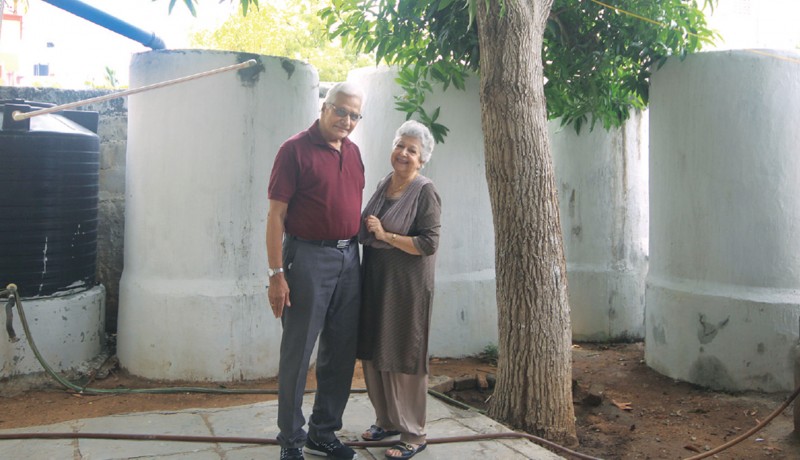
People

During the 1965 War, we were in one of the flying stations up North. We were a bunch of enthusiastic servicemen, very cool with the idea of going to war, and happy with comrades and flyers from other squadrons. No one was unduly perturbed—till the bombs started falling! That is when we started digging trenches to save ourselves.
Today’s water situation in India is like that—the proverbial bombs are falling and we have still not dug our trenches. Every home with an open terrace needs to save rainwater, which we as a country have so much of. More often than not, we let it flow on to the street and down municipal drains.
My wife Enid and I set in motion our plan to save rainwater in 2011, one of the main reasons being my love for my garden. When we moved into our house in Vellapore in 1989, we set up a garden with great care and have nurtured it since. Then, when the water shortages hit, we wanted to save rainwater mainly because we did not want to give up the garden!
We ordered four large pipes and set them up vertically on bases made of brick and mortar. There were our ‘tanks’. We laid pipes on all six exit points for rainwater that flowed down from the terrace and joined all of them at one point, where a common pipe connected them to the first of the four ‘tanks’. All four tanks were connected at the base, so we could collect as much water as the tanks could hold. With the first rain in 2011, all the tanks filled up. Next year, we added another tank—this time, one of those large black, synthetic water tanks.
Our holding capacity was now up to 8,500 litre. I use this water for gardening and coolers through the lean season of summer when our water supply is curtailed. I do not use this water for personal consumption. If you want to do that, you need to set up filters on all the exit points from the terrace. Then, the water can be used in the toilets, in washing machines, etc. A further round of boiling and purifying would probably make it fit for drinking.
Five years ago, the whole project cost me ₹ 70,000. I spent another ₹ 25,000 on repairs of the leaking tanks. My advice to others wanting to copy this model is to straightaway use synthetic water tanks. Better still, if you have the space, embed them in the ground. We could not do that as we did not want to uproot our old mango trees.
My message to all those who have an open terrace: please save water and use it. We keep digging borewells and they keep drying out. In our locality, people have gone down thousands of feet searching for water. How long will the subterranean water last at the rate at which we are digging it up? This is a simpler solution. All said and done, the rain will never stop!
—Air Vice Marshal (retd) Edwin Godfrey Salin, Hyderabad
Photo: Shyamola Khanna Featured in Harmony — Celebrate Age Magazine August 2016
you may also like to read
-
For the love of Sanskrit
During her 60s, if you had told Sushila A that she would be securing a doctorate in Sanskrit in the….
-
Style sensation
Meet Instagram star Moon Lin Cocking a snook at ageism, this nonagenarian Taiwanese woman is slaying street fashion like….
-
Beauty and her beast
Meet Instagram star Linda Rodin Most beauty and style influencers on Instagram hope to launch their beauty line someday…..
-
Cooking up a storm!
Meet Instagram star Shanthi Ramachandran In today’s web-fuelled world, you can now get recipes for your favourite dishes at….







